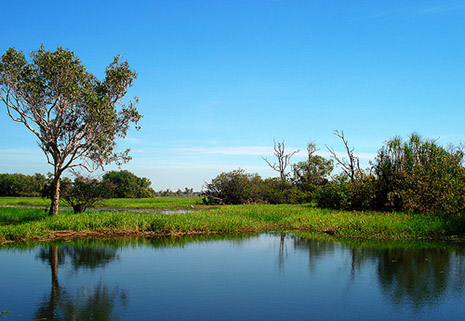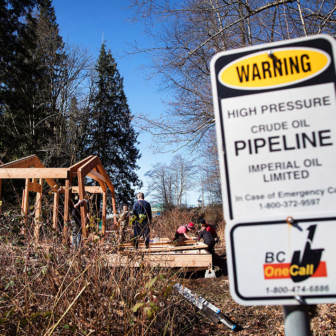People on Country: Vital Landscapes, Indigenous Futures
Edited by Jon Altman and Sean Kerins | Federation Press | $39.95
INDIGENOUS Australia presents a conundrum for environmentalists. The recognition of native title rights means that the most disadvantaged Australians are now legal custodians of vast areas of the natural landscape – some 20 per cent of Australia – dwarfing the mainstream Australian conservation estate. The conservation value of Indigenous lands is increasingly recognised by government land management agencies and non-government conservation organisations, and has resulted in innovative joint management schemes building on the pioneering approach at Kakadu National Park. Yet despite the explicit recognition of Indigenous ownership, such arrangements have largely failed to empower or provide employment opportunities for most Indigenous people. This book describes these experiments and helps explain why the efforts are fraught.
The most compelling feature of People on Country is the testimony of the Indigenous participants in “ranger” or “caring for country” programs designed to give employment and natural resource management responsibilities to custodians of traditional lands. Many of these Indigenous communities are truly asset rich and income poor, owning vast lands yet offering vanishingly few opportunities for employment and little incentive for a younger generation to pursue education and employment. As a result, many remote Indigenous communities have become diabolical poverty traps, replete with damaging social dysfunction. Ranger programs, often underwritten by welfare payments, are one of the few bright spots on an otherwise bleak horizon. Outdoor activity, including ranger work, has also been proven to make a significant contribution to improving the chronic ill health of Indigenous people.
Yet Indigenous engagement in natural resource management throws up deep philosophical issues that invariably collapse into conflicts over ideology and values. Indigenous people have a customary right to hunt and fish on their traditional lands, for instance, but should such wildlife exploitation be a key component of Indigenous nature reserves? And what about the question of animal rights and ethics; should the funders of Indigenous natural resource management programs turn a blind eye to traditional methods of killing wildlife (and feral animals) that may be considered cruel by non-Indigenous people? Indigenous people also have a fundamentally different perception of risk in the bush, so there is a profound mismatch between mainstream occupational health and safety – safety boots, for instance – and the reality of Indigenous bush life, where walking bare-footed is second nature.
A greater challenge for ranger programs lies in the fact that many Indigenous people combine invaluable local knowledge with very low levels of educational attainment. How should this mismatch be reconciled so that traditional ecological knowledge is recognised as a key attribute that deserves financial reward? The reality is that natural resource management programs depend on numerous non-Indigenous participants who can navigate the shifting sands of bureaucratic and academic terminology, make sense of the steady turnover of government programs with mind-numbing acronyms, and attract and acquit funds.
People on Country highlights these tensions between the Indigenous and non-Indigenous participants. The chapters by the academic protagonists are clearly written to impress, and in some cases chide or even shame, their fellows in the academy and the bureaucracies. As a consequence, the reader is introduced to the esoteric debating points, drawn from the social and ecological sciences, inherent in Indigenous natural resource management “discourse.” This kind of highbrow writing jars with the plainer language of the Indigenous testimonies.
This mismatch in style and approach is inevitable given the genesis of the book; essentially it is the accountability step of a number of research programs funded by government and philanthropic foundations. As a consequence, there is a narrow focus on the Australian National University–based research group’s achievements, which has been sharpened by their decision not to attempt a comprehensive review of the literature generated by others working in this field.
The book is also a work of advocacy, which is fair enough, but that tends to compromise the depth of scholarship and therefore limits its shelf life. There is no certainty that the hopes outlined in this book will translate into the dominant mode of existence for remote Indigenous communities. Indeed, the authors repeatedly allude to the competing, and currently ascendant, vision of Indigenous development that places an uncompromising emphasis on integrating the next generation of Indigenous people into the mainstream economy, with the consequent pressure for children to meet national education standards. Funding is being directed to building this capacity in more economically efficient regional hubs rather than sustaining the remaining remote bush communities where Indigenous traditional life persists tenuously.
Discussion about Indigenous land management often focuses on northern Australia. But the majority of Indigenous people live in southern Australia, where they face greater challenges to gain rights, or even access, to land than do their counterparts in the north. As an interesting counterpoint to the situation in northern Australia, People on Country describes the challenges faced by Indigenous people in more densely populated New South Wales in trying to gain rights to land and to build the capacity to manage natural resources. In contrast to the north, Indigenous natural resource management groups in New South Wales have fewer assets and greater administrative challenges, and must often compete with existing natural resource managers. Forging enduring partnerships to get access to and manage traditional lands, let alone becoming major players in natural resource management more broadly, remains a critical challenge. Achieving this demands higher levels of education, improved administrative capacity, greater financial resources and greater respect for traditional rights.
The authors know only too well that funding, and especially enduring funding, is a critical challenge for Indigenous natural resource management. It is true that the private sector and the non-government nature conservation organisations are interested in partnering with Indigenous landowners, yet these arrangements are neither straightforward nor free from external priorities and performance targets that may prove unworkable in the future. Concerns about the carbon economy might ultimately override other views about the way land should be managed, for instance, and nature conservation agreements may preclude traditional harvests of wildlife. The sustainability of non-government funding is also uncertain.
Ultimately government funding will remain pivotal for bush Indigenous communities. According to one argument advanced in People on Country, it is the moral responsibility of government to help restore the condition of traditional lands degraded through inappropriate management by settler Australians. This moral claim can be countered by the moral imperative to improve Indigenous health, employment and education dramatically. The authors ignore the fact that governments are generally losing interest in substantial natural resource management expenditure, which is compromising the functioning of nature reserves throughout Australia. There is serious talk of de-gazetting “under-performing” national parks in some jurisdictions, and of outsourcing management to NGOs. It is a bad time to be seeking substantial and long-term government funding for Indigenous lands.
Nevertheless, this is a valuable book that can be read in many ways: it is useful for those interested in contemporary natural resource management and Indigenous development politics, and it highlights the dilemmas inherent in researching in cross-cultural settings. Indeed, as a document it can be deconstructed to illuminate the changing ways contemporary Australian culture is attempting to reconcile with its deep Indigenous past. •




